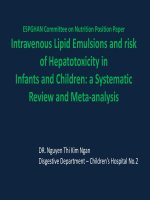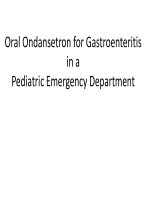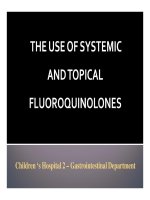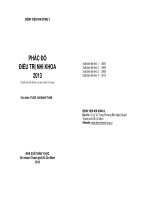Pain management in neonate | Website Bệnh viện nhi đồng 2 - www.benhviennhi.org.vn
Bạn đang xem bản rút gọn của tài liệu. Xem và tải ngay bản đầy đủ của tài liệu tại đây (556.78 KB, 11 trang )
PAIN MANAGEMENT IN
NEONATE
Children’s Hospital 2
Neonatal Department
Acute effects of neonatal pain
• Loss of normal behaviors.
• Expression of abnormal behaviors.
• Reaction to touch.
• Physiological : increased HR and BP, decreased SpO2
• Hormonal and metabolic : increased plasma renin activity and
adrenalin, noradrenalin, cortisol
Long-term
term effects of neonatal pain
• Alter the normal development of the central nervous system.
• Hyperalgesia.
• Impairs normal development of both excitatory and inhibitory synaptic
function.
• Poorer cognitive and motor scores, impairments of growth, reduced white
matter and subcortical gray matter maturation, and altered corticospinal
tract structure.
Procedural Pain and Brain Development in
Premature Newborns
• Cohort study :24 to 32 weeks GA, from 7/2006 to 1/2009 / III NICU at
Children’s and Women’s Health Centre of British Columbia.
• Greater neonatal procedural pain was associated with reduced white
matter FA (b ¼ 0.0002, p ¼ 0.028) and reduced subcortical gray matter
NAA/ choline (b ¼ 0.0006, p ¼ 0.004).
• Early procedural pain in very preterm infants may contribute to impaired
brain development.
2012 American Neurological Association
The frequency of painful procedures in neonatal
intensive care units in South Korea
• The number of painful procedures increased as the gestation period
became shorter and birthweight decreased . This prospective study was
done with all newborns admitted to the NICUs between 1 October and 20
November 2010.
• Neonates in two NICUs in Republic of Korea during the first 14 days of
admission.. A total of 15 313 of painful procedures were performed with an
average of 105.6 painful procedures per baby and 7.5 per day per baby.
International Journal of Nursing Practice 2014; 20: 398–407
A Prospective Study of Pain Experience in a Neonatal
Intensive Care Unit of China
• Data performed on 108 neonates (term, 62; preterm, 46) recruited from
admission to discharge in a NICU of a university-affiliated
university
hospital in China
between 2010-2011
• During hospitalization each preterm and term neonate was exposed to a
median of 100.0 (range, 11 to 544) and 56.5 (range, 12 to 249) painful
procedures, respectively. Preterm neonates, especially those born at 28
and 29 weeks’ GA, experienced more pain than those born at 30 weeks’
GA or later (P<0.001). Tracheal intubations was the most painful.
Clinical Journal of Pain,October 2012
TOOL
PIPP
PARAMETERS
Gestational age, behavioral state, heart rate, oxygen
saturation, brow bulge, eye squeeze, nasolabial furrow
SCORE
UTILITY
Total : 0-21
≤6 minimal pain
>12 moderate to severe pain
Total : 0-10
>4 moderate pain
>7 severe pain
Total: 8–40
17–26 adequate sedation;
≥27 inadequate sedation/analgesia
Procedural and
postoperative pain
FLACC
Face, legs, activity, cry, consolability
COMFORT
scale
Alertness, calmness, respiratory distress, movement,
muscle tone, facial tension, blood pressure, heart rate
COMFORT
behavior scale
Alertness, calmness, respiratory response (ventilated
ventilated
neonate) or crying (not ventilated), movement,muscle
tone,facial expression
Total: 8–30
>17 moderate pain requiring
intervention
Postoperative
pain in NICU
NIPS
facial expression, cry, breathing patterns, arms, legs, state
of arousal
Total: 0-7
≥4 moderate pain requiring
intervention
Procedural pain
NFCS
Brow bulge, eye squeeze, deepening of nasolabial furrow,
open lips, mouth stretch,tongue tautening, tongue
protrusion, chin quiver
Total: 0-8
≥3 moderate pain requiring
intervention
Procedural pain
N-PASS
Crying irritability, behavior state, facial expression,
extremities tone, vital signs ( HR, RR, BP, SaO2 )
Total: 0-10
>3 moderate pain requiring
intervention
Procedural ,
ventilated and
postoperative pain
CRIES
Crying, facial expression, sleeplessness, required oxygen
to stay at > 95% saturation, increase vital signs
Total: 0-12
≥4 moderate pain requiring
Postoperative
pain
Procedural and
postoperative pain
Pain and
sedation in
NICU
Procedure
Gastric tube insertion
Stepwise intervention
Step 1, consider Step 2
Comments
Perform rapidly, use lubricant, avoid injury
Heelstick
Step 1 + use mechanical lance
Venipuncture’s more efficient,less painful; Step
2,3 + heel warming
Adhesive removal
Use solvent swab,consider Step 1 or 4
Venipunture
Step 1 + 2
Reqire less time + less resampling than
heelstick
Removal of IV catheter Solvent swab, consider Step 1
Tracheal intubation
Step 4 or 6,use muscle relaxant oly if
experienced clinician, consider atropine
Superiority of a specific drug regimen over the
others has not been investigated
Tracheal extubation
Solvent swab, consider Step 1
Step 1 maybe use after procedure
Central line placement Step 1,2,5 consider Step 4 or 6
Some centers prefer using general anesthesia
Umbilical
catheterization
Lumbar puncture
Step 1, avoid suture on skin
PICC line placement
Step 1,2 consider Step 4,5
Cord tissue is not innervated, avoid injury to
skin
Consider Step 4 if patient is intubated/
ventilated
Some centers prefer using general anesthesia
Step 1,2,5 carefull positioning
CONCLUSION
Effective management of procedural pain in neonates is
required to minimize acute physiological and behavioral
distress and may also improve acute and long-term
Outcomes !!!









